The 12 Common Mistakes When Measuring Heart Rate Variability
Be sure that you are not making these common mistakes when measuring your heart rate variability (HRV) – so you get the most out of your HRV measurements.
Home » Heart Rate Variability » What are Heart Rate Zones & how to calculate it with Welltory

One could simply explain heart rate training zones as a way of monitoring how hard you’re training. There are five heart rate zones based on the intensity of training with regard to your maximum heart rate:
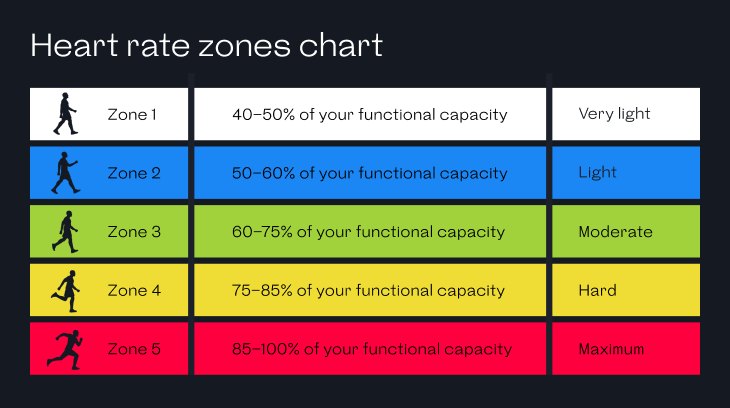
Very light: Working in zone 1 means that you’re using only 40-50% of your functional capacity. Training here will boost your recovery and prepare you for higher zones.
In order to work at this level, pick a type of exercise that allows you to easily control your heart rate, such as walking. Although this is a very light form of training, it does make you healthier. Read here all about it.
Light: Exercising in zone 2 feels light and will let you go on for a long time.
This is the level that allows you to improve your overall endurance: your body will get better at burning fat, oxidizing and your muscular fitness will increase along with your capillary density.
Working in heart rate zone 2 is a crucial part of each and every exercise program. If you keep at it you’ll reap the benefits later.
Moderate: Exercising in zone 3 is particularly effective for improving the efficiency of your blood circulation in the skeletal muscles and in the heart. This is considered as the heart rate zone in which that pesky lactic acid starts to build up in your bloodstream.
Training here will make moderate efforts much easier and will further improve your general efficiency.
Hard: In heart rate zone 4, it gets tougher. You’ll be breathing considerably harder and will be working aerobically.
Training at this intensity will improve your speed endurance by a lot. Your body gets better at using carbohydrates for energy and you’ll manage to withstand higher levels of lactic acid in your blood for a longer time.
Maximum: Zone 5 is your absolute maximal effort. Your heart, blood and respiratory system will work at their maximal capacity. Lactic acid builds up in your blood and after only a few minutes you’ll have to drop the intensity.
If you’ve only been training for some time, you most likely won’t have to work at this intensity. As a professional athlete, you should look into incorporating interval training and implementing it into your exercise plan for peak performance.
In order to identify your heart rate zones, you have to calculate your maximum heart rate, allowing you to exercise at an appropriate intensity, both for heart safety’s sake and to achieve your personal fitness goals. This can be calculated in different ways, some considered less accurate than others. Three common ways are through the classic age-based formula, stress testing or a more challenging one being self-field testing.
The age based formula: 220 – your age is a simple way of telling, however the concept has been proven to be rather inaccurate, especially among older people.
Stress testing would involve a cardiologist setting up a session, unless you’re aspiring to be a world-class athlete and head to an elite training facility.
The Welltory app calculates heart rate zones according to specific algorithms.
Welltory applies a unique formula* that uses your personalized maximum HR and recent resting HR alongside your training intensity:
Target training HR = resting HR + (0.5 [208 − 0.7*your age − resting HR]) where 0.5 equals 50% of your functional capacity.
We calculate your maximum HR using a regression equation to predict HR max in healthy adults. This equation was proved to be accurate in the meta-analysis of 351 studies involving 18,712 subjects:
Max HR = 208 – 0,7 * age
If we’ve obtained your maximum HR within the last year, we compare it with the formula’s result and use the greater value for more accuracy.
Your resting HR is determined through your most recent data from your heart rate variability measurements in the past 7 days, unless we can obtain data from your fitness tracker that provides information about today’s resting HR.
If such data is unavailable, we’ll use the arithmetic mean of your lowest HR scores.
If there’s no information on your HR at all, we’ll turn to the default value of 55 bpm.
With this information we are able to calculate both the lower and the upper HR value for the different zones.
Example: (Light zone)
Lower value for the light zone (40 percent):
Resting HR + (0.4 [maximum HR − resting HR]) where 0.4 stands for 40% of your functional capacity.
Upper value for the light zone (50 percent):
Resting HR + (0.5 [maximum HR − resting HR]) where 0.4 stands for 50% of your functional capacity.
To provide an example – let’s say you are a 30-year-old man. Your resting HR is 50 bpm, the maximum HR is 190 bpm. Your HR ranges for zones 1–5 will then be as follows:
106–120 bpm for the Very light zone, 40–50% of your functional capacity
120–134 bpm for the Light zone, 50–60%
134–155 bpm for the Moderate zone, 60–75%
155–169 bpm for the Hard zone, 75–85%
169–190 bpm for the Maximum zone, 85–100%
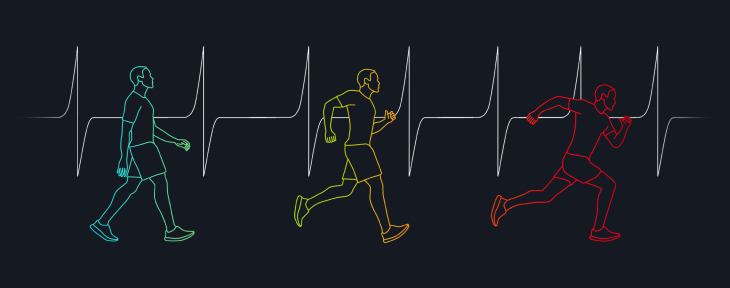
Heart rate-based training enables not only professional athletes to work at the right intensity in order to reach their training goals, but it also serves as a great guide for you to know at what level you’re exercising.
Your heart rate zones tell you how hard your heart is working and what energy source you’re using.
A lower heart rate indicates that your heart is working well. It pumps more blood with each contraction and keeps a regular beat.
This might imply that a higher resting heart rate means the opposite. However, Marina Kovaleva, certified personal trainer, Lead researcher, and Data scientist at Welltory, says that this is applicable only when comparing RHR = 80 vs RHR = 60, but not when comparing RHR = 55 vs RHR = 40.
The United States National Institutes of Health (NIH) have published a list of normal resting heart rates taking age into consideration.
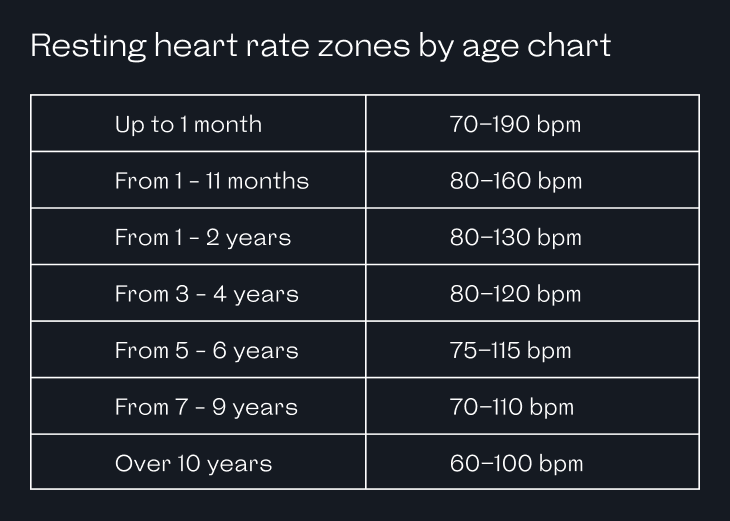
In this section, we will tell you more specifically what heart rate zones to stick to when working out. An effective workout plan or a specific training goal requires profound knowledge in regard to exercise duration, frequency, and intensity. A greater understanding of heart rate zones training will support motivation to create an efficient and personal workout plan.
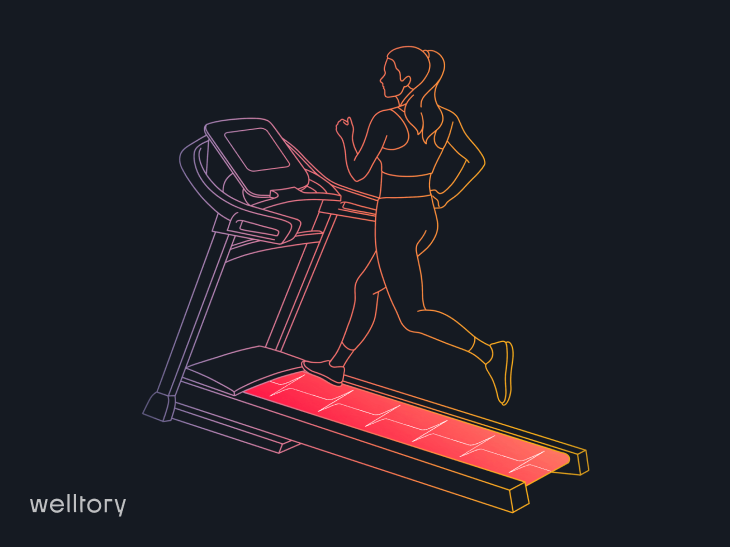
If you’re considering running as a new training form, heart rate training is highly motivating as it helps you to understand how hard your body is working and how much you ought to increase or decrease your intensity. If you’re struggling with the get-up-and-go, see our article about how to start running like a pro. Depending on your goals, you may spend your time in different heart rate workout zones. For example, if you’re training for a 5K, you might want to spend most of the time in zones 3 to 4. Using a heart rate monitor will help you to keep track of your training.
If you find yourself continuously working in zone 4 or higher, you might want to slow down.
Marathon runners however usually focus on keeping a steady pace for a longer distance. They may want to spend as much as half of their training in zones 1 and 2. Doing some speed or interval training in zones 3 and 4 is however also healthy and strengthening and is therefore generally an additional part of their workout.
Elite athletes and sprinters may focus more of their training in zones 4 and 5.
Heart rate zones can be considered as guidelines telling you how hard you’re working, to what extent you can increase the intensity of your workout and further, they let you know when it’s time to loosen the pressure. In this way, for instance, you won’t have to worry about pushing yourself too hard, damaging your health.
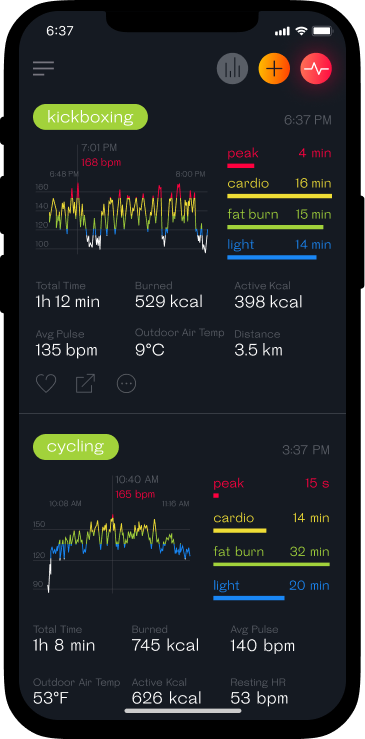
Welltory’s move plan feature can help you with these complex calculations by keeping track of your body’s current state, general fitness, and activity level, and based on additional data such as your step count and heart rate, we evaluate your goals and heart rate zones.
Welltory Team, 20 Jan. 2023

Be sure that you are not making these common mistakes when measuring your heart rate variability (HRV) – so you get the most out of your HRV measurements.
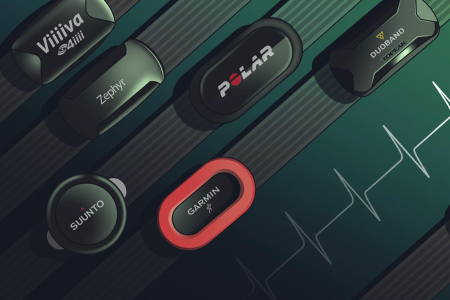
Measure heart rate variability with the best HRV Monitors Compatible With Welltory

A clear explanation of heart rate variability, what it is, and how to use it. What does heart rate variability tell you and how to understand it in simple words.

The Ultimate HRV guide about what Heart Rate Variability is and how to implement HRV in daily life with Welltory

7 simple rules for accurate heart rate variability measurement.
Find out how heart rate variability measurements are taken with smartphone cameras and heart rate monitors.
 App Store
App Store
 Google Play
Google Play
 Huawei AppGallery
Huawei AppGallery
 Galaxy Store
Galaxy Store



